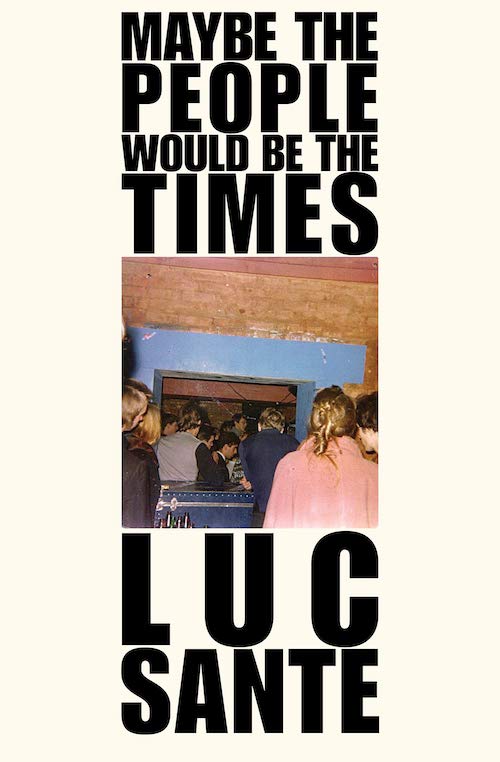
If Luc Sante wrote the phone book I’d read it. Twice. Happily, Sante’s new book Maybe the People Would Be the Times gathers pieces about music, art, and city life from the last twenty-plus years, so what he writes about is as compelling as the style with which he does it. Sante stubbornly refuses to write a stale line. Whether paying tribute to the young Patti Smith or imagining the subsequent lives of the original owners of 45s in his collection or recalling the long-gone businesses and denizens of the Lower East Side, he puts the reader right there, seeing what he saw, thinking what he thought.
Divided into five sections devoted, respectively, to music, adolescence, heroes, photography, and the old neighborhood, there are many overlaps in themes and subject-matter. As he notes early on, “Almost everything of interest in New York City lies in some degree of proximity to music.” The city of his youth is one of possibility, a place where resourceful people can try and fail at poetry, painting, filmmaking, or music, dust themselves off and start anew the next day. Hiphop and No Wave are being birthed before his eyes and ears. There is little money to be made, so everyone is willing to take chances. It’s a place and time which would be as alien as a moonscape to a current visitor. Yet by vividly evoking the lives and the work of 70s and early 80s Sante makes that ghost city feel a thousand times more real than the posh Disneyfied creation which occupies the same geography today.
The pieces which deal with his early attempts to fit into American culture as an immigrant immediately rang a bell for me. That desperate, all-consuming study of the TV shows, records, magazines, and books of your new country in order to fast-forward inclusion and participation is all too familiar. It’s an added burden on top of the common unease of childhood and adolescence to have to translate the new and pretend to disown the old. Parents become strangers because they came of age overseas and often need you to interpret the simplest everyday thing in this new adopted land. It’s a discomfort not easily explained to your new American friends. Nobody wants to stand out until much later in life. When Sante writes of his mother, that “my failings wounded her, and my successes meant nothing to her because they occurred in a world she couldn’t or wouldn’t understand.” I know exactly what he’s talking about.
His enthusiasm for the work he loves is contagious. Who wouldn’t run to the nearest bookstore for the entire run of Donald Westlake’s Parker crime novels after reading that “You can consume the entire series and not once have to invest in a bookmark.” Upon finishing Sante’s tribute to pioneering film critic and painter Manny Farber I immediately reserved a book of his writing from the local library. I’d tried reading Farber many years ago but was maybe too young to get on his wavelength. Sante’s essay made me reconsider an assumption, which is an ultimate success any piece of writing could aspire to. To make a reader see a thing he thought he knew as if he’d never seen it before.
Sante also saves me the trouble of delving into work I was marginally curious about but avoided. He says of H.P. Lovecraft, “Where he fails utterly is in conveying lived experience, the material counterweight to his phantoms.” This confirms my suspicion that Lovecraft isn’t for me, but I read about him with as much interest as the essay on Georges Simenon—a writer I enjoy and respect. In the case of these two writers, Sante skillfully delineates the paradoxes and contradictions of their art versus their lives. It’s so often true that deeply flawed individuals leave the best of themselves on the page, tape, or screen. Whether an unabashed fan or harboring major misgivings, Sante makes us see artists in all their complexity and gives them their due. They’re lucky to have him as a reader, listener, and viewer.
Sante is one of the very few writers who almost makes me like photography. The pieces on vernacular, anonymous, and street photos are some of the most incisive in the entire collection. Sante understands the tabula rasa nature of the medium, how meaning is so often imposed on pictures by the viewer. He uses the images as a jumping off point for poetic speculation and for ruminating on unanswerable queries. When writing about a well-known figure like Weegee, he elevates the chronicler of crime-scene carnage to the museum realm, while ruefully noting how he never got his due while still alive.
I put Sante up there with Joseph Mitchell as an observer of street-level life. This new collection, which follows the equally essential Kill All Your Darlings, is a must for anyone curious about art and culture made in this country during the last era when what’s new was gleaned firsthand, in the flesh, rather than passively received by screen. Remnants of that world persist, but you have to squint hard to still see it. Sante renders it with 20/20 stereoscope clarity.
***
Maybe the People Would Be the Times
by Luc Sante
Verse Chorus Press; 336 p.
Follow Vol. 1 Brooklyn on Twitter, Facebook, and sign up for our mailing list.
